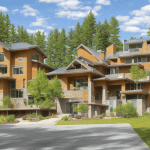Amidst the challenges that climate change presents, we are suddenly encountering an urgent need to revise the principles of real estate development. The local communities that we build our structures in are far from impervious to the heat waves, water shortages, and energy crises brought about by changing weather patterns. This article aims to provide you with an insight into how to design real estate projects that not only withstand these impacts of climate change but also contribute to the resilience of the communities they are part of.
Incorporating Climate Resilience in Project Design
In the previous era, the focus of real estate development was primarily on aesthetics, functionality, and profitability. However, as the impacts of climate change become increasingly palpable, a shift towards more resilient designs has become a necessity. Incorporating climate resilience in project design involves considering extreme weather events and long term climatic changes, and ensuring that the structures can withstand these conditions.
Sujet a lire : How can real estate developers utilize thermal energy storage to enhance building efficiency?
Climate resilience must be a mandatory consideration in every phase of the project, from site selection to building design, and even to the materials used in construction. Infrastructure should be designed with the capacity to absorb climate shocks and stresses, and should be flexible enough to adapt as climate conditions continue to change. Furthermore, the use of renewable energy sources and water-efficient systems can help to lessen the project’s impact on local resources and contribute to mitigating the effects of climate change.
Building Green and Sustainable Communities
Real estate developments are more than just structures. They are integral parts of communities. In designing projects that support and enhance community resilience, it is essential to consider the broader environmental context and aim to create green and sustainable communities.
A voir aussi : What innovative financing and investment strategies can support the development of affordable real estate housing?
A green community will minimize its impact on the environment by consuming fewer resources and producing less waste. This involves implementing energy-efficient building designs and making use of renewable energy sources. Water management is also a critical aspect of green communities, with strategies such as rainwater harvesting and greywater recycling being highly beneficial.
On the other hand, a sustainable community goes beyond environmental considerations to look at the social and economic aspects of sustainability. This might involve creating affordable housing options, providing access to essential services, and ensuring that the development contributes positively to the local economy.
Adapting Infrastructure to Extreme Heat
One of the more immediate and tangible impacts of climate change is the increase in temperature, leading to more frequent and severe heatwaves. Buildings and infrastructure need to be adapted to handle these conditions, to ensure not only the safety and comfort of occupants but also the longevity of the structures themselves.
Design strategies that can mitigate the effects of heat include green roofs and walls, which can reduce the heat absorbed by buildings; shading structures, to provide protection from direct sunlight; and natural ventilation systems, to reduce the need for energy-intensive air conditioning. It’s also beneficial to incorporate cool materials in construction, which reflect more sunlight and absorb less heat. These measures can significantly reduce the urban heat island effect, a phenomenon where urban areas become significantly warmer than their rural surroundings.
Action at the Community Level
While individual projects can contribute substantially to community resilience, broader action at the community level is essential. This includes developing local climate action plans, enacting sustainable building codes, and creating incentives for green development.
Community-led initiatives, such as renewable energy cooperatives or community gardens, can also play a significant role in enhancing resilience. These initiatives not only help to mitigate the impacts of climate change but also foster a sense of community and shared responsibility.
Health and Well-being in a Changing Climate
Lastly, it’s important to remember that climate change doesn’t just impact our buildings and infrastructure – it also has profound implications for human health and well-being. Increased heat can lead to a range of health issues, from heat stroke to exacerbated respiratory problems, and changes in climate can also influence the spread of diseases.
Resilient real estate projects should therefore consider the health and well-being of occupants and community members. This could be achieved through strategies such as providing ample green spaces, which can reduce heat and improve mental health; ensuring good indoor air quality; and incorporating active design principles to encourage physical activity.
Designing real estate projects that support and enhance community resilience to climate change is no small task. It requires a shift in thinking, a willingness to innovate, and a commitment to sustainability. However, the potential benefits – for both the environment and the community – make it a challenge worth taking on.
Integrating Climate Adaptation in Master Planned Communities
It is no longer sufficient to plan communities without taking into account the long-term impacts of climate change. Today, climate adaptation has to be a key component in master planning communities. A master planned community that is designed to adapt to climate change is one that is prepared for sea level rise, extreme heat, and other changes in weather patterns that are predicted to occur.
To accomplish this, communities need to invest in a variety of best practices that include the construction of green infrastructure, like parks and open spaces, that can absorb excess rainwater and reduce flooding. Buildings should be constructed with climate-resistant materials and designs to withstand extreme weather conditions. Sea walls and other protective barriers should also be considered in coastal areas to counter sea level rise.
Additionally, real estate developers need to work closely with state and local governments to incorporate climate adaptation strategies into the planning and building codes. By doing so, communities will be better prepared to withstand the impacts of climate change while also providing a high quality of life for their residents.
Collaboration with local communities is crucial to the success of these projects. Developers should strive to engage residents in the planning process through community engagement initiatives. This can help ensure that the needs and concerns of the community are addressed in the design of the project, and that the project itself contributes to the overall resilience of the community.
Harnessing Renewable Distributed Energy Resources
As we face the reality of climate change, there is an increasing need to reduce carbon emissions and reliance on fossil fuels. Harnessing renewable distributed energy resources is a powerful solution to this problem and can significantly contribute to the resilience of our communities.
Renewable distributed energy resources, such as solar panels and wind turbines, generate power at the source of consumption, thereby reducing the need for long transmission lines and the losses associated with them. These sources are also inherently resilient as they are less likely to be affected by extreme weather events.
Real estate projects can incorporate these renewable distributed energy resources in their design, either by installing solar panels on rooftops or integrating wind turbines into the architecture. Not only does this approach reduce the project’s carbon footprint, but it also contributes to energy security and independence for the community.
Moreover, the use of cool surfaces, such as green roofs and reflective pavements, in conjunction with renewable energy installations, can help to reduce the urban heat island effect and ensure that our buildings and communities stay cool even during intense heatwaves.
Conclusion: A Holistic Approach to Climate Resilient Real Estate Development
In conclusion, designing real estate projects that support and enhance community resilience to climate change requires a comprehensive and forward-thinking approach. It is about integrating climate resilience into every aspect of the project, from site selection and building design to the choice of materials and energy sources.
It also involves building green and sustainable communities that are mindful of their environmental impact, and that strive to enhance the well-being of their residents. Furthermore, it entails adapting our buildings and infrastructure to withstand extreme heat and other climate-related challenges, and promoting renewable distributed energy resources for a more sustainable and resilient future.
While the task is challenging, the potential rewards are immense. Not only can we create more resilient communities that can withstand the impacts of climate change, but we can also improve the quality of life for residents, contribute to a more sustainable future, and, ultimately, create a real estate market that is successful over the long term. By working together – developers, local government, and communities – we can rise to the challenge and turn these ambitions into reality.










